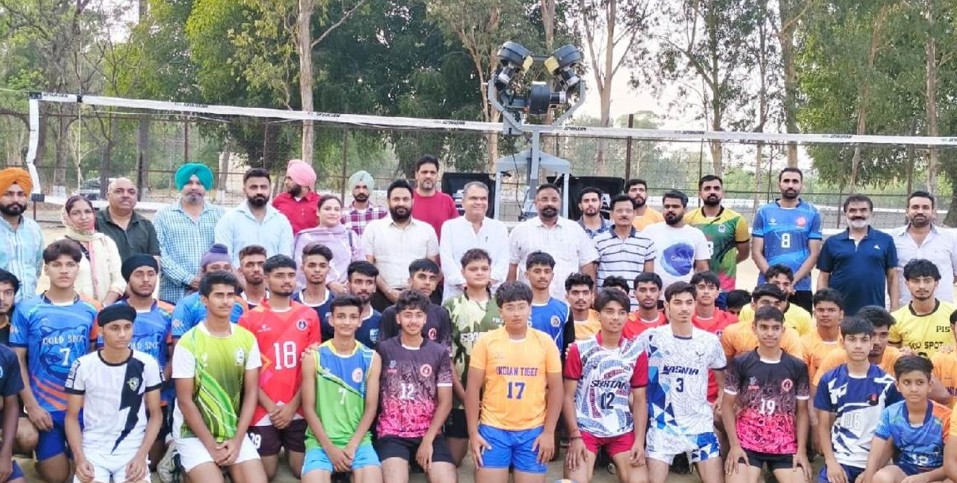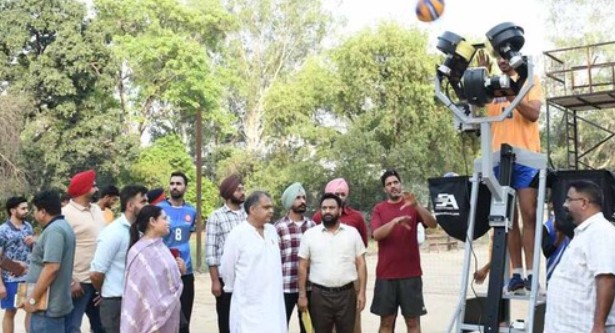A silent revolution is quietly brewing on the volleyball courts of a government college in Punjab, marking a significant stride in sports training infrastructure within the state. This transformative change has arrived in the form of the state’s very first volleyball pitching machine, a cutting-edge piece of equipment that promises to revolutionize the way aspiring volleyball players hone their skills. While the specific name of the college has not been publicly identified in this initial announcement, the mere fact of its installation represents a monumental leap forward for grassroots sports development and underscores a growing commitment to equipping young athletes with modern training tools that were once the exclusive domain of elite private institutions or national sports academies.
The acquisition of a volleyball pitching machine is far more than a mere addition to a sports equipment inventory; it signifies a strategic investment in the future of volleyball in Punjab. Traditionally, volleyball training relies heavily on human pitchers – coaches or fellow players repeatedly tossing or serving balls for practice. While invaluable for basic drills and game simulation, human pitching has inherent limitations. Consistency in speed, trajectory, and placement can vary, leading to less effective repetitive drilling. Moreover, it places considerable physical strain on the pitchers, limiting the volume and intensity of practice sessions. A pitching machine, conversely, offers unparalleled precision, consistency, and endurance, making it an indispensable asset for targeted skill development.
This advanced piece of equipment is designed to deliver balls with remarkable accuracy, replicating various types of serves, passes, and sets at adjustable speeds and angles. Imagine a player needing to perfect their reception of a powerful float serve. With a human pitcher, achieving dozens of identical float serves in a short span is virtually impossible. A pitching machine, however, can be programmed to deliver precisely the same serve repeatedly, allowing the player to focus solely on their footwork, body positioning, and contact point, leading to faster muscle memory development and skill refinement. Similarly, it can mimic jump serves, topspin serves, or even rapid-fire setting drills, enabling players to practice specific game situations in a controlled and repeatable environment.

The implications for the students and coaches at this government college are immense. For the players, it means access to a level of training previously unavailable to them. They can now engage in high-volume, high-repetition drills without overwhelming their coaches. This constant, consistent feedback from the machine allows for quicker identification and correction of technical flaws. Players can practice specific skills like digging powerful spikes, receiving tricky serves, or perfecting their setting accuracy for extended periods, building confidence and refining their technique at an accelerated pace. This kind of focused, uninterrupted practice is crucial for transforming raw talent into polished performance.
For the coaching staff, the pitching machine frees up valuable time and energy. Instead of expending effort on repetitive pitching, coaches can now concentrate on observing their players more closely, providing real-time feedback, analyzing technique, and strategizing game plans. They can design more sophisticated and challenging drills, knowing that the machine will deliver the balls precisely as needed. This shift allows coaches to become more effective mentors and strategists, elevating the overall quality of training. It also mitigates the risk of injuries to coaches from repetitive pitching motions.
The installation of such a sophisticated machine in a government college also carries profound symbolic weight for sports development in Punjab. Historically, state-funded institutions have sometimes lagged behind private academies in terms of cutting-edge sports infrastructure. This acquisition signals a strong commitment from the government to democratize access to advanced training tools, ensuring that talent from all socio-economic backgrounds has an equal opportunity to excel. It sends a powerful message that the state is serious about nurturing sporting talent at the grassroots level and is willing to invest in the resources necessary to compete at higher national and international platforms. It will undoubtedly inspire other government colleges and sports academies across Punjab to advocate for similar technological upgrades, fostering a culture of innovation and excellence in sports training.
Beyond skill development, the machine can also aid in physical conditioning and mental fortitude. Players can train against high-speed serves or rapid-fire drills, pushing their physical limits and improving their reaction times, agility, and endurance. The consistent nature of the machine also helps in building mental resilience, as players learn to maintain focus and concentration through repetitive, demanding exercises, mimicking the sustained pressure of competitive matches.
The success of this initiative could pave the way for similar investments in other sports and other institutions across Punjab. If this college demonstrates significant improvement in its volleyball team’s performance, it could serve as a powerful case study for the efficacy of modern training equipment. One could envision similar pitching machines for cricket, tennis ball machines, or even advanced analytics tools becoming more commonplace in state-funded sports programs. Such advancements are crucial for a state like Punjab, which has a rich tradition of producing athletes in various disciplines.
The ultimate aim of such an investment extends beyond winning local tournaments. It is about elevating the standard of volleyball in Punjab, enabling its players to compete at national championships with greater confidence and skill, and ultimately contributing more talent to national teams. For a young student from Faridkot, or any other part of Punjab, knowing that their local government college is equipped with tools comparable to those used by professional athletes can be a tremendous source of motivation and encouragement. It reinforces the belief that with hard work and access to the right resources, their sporting dreams are indeed within reach.
The arrival of the state’s first volleyball pitching machine at this government college is not merely an isolated incident of equipment acquisition; it is a landmark event that signifies a crucial paradigm shift in sports development in Punjab. It is an investment in technology, in coaching efficiency, and most importantly, in the unfulfilled potential of countless young athletes who are eager to serve, set, and spike their way to glory. The ripples of this innovation will undoubtedly spread, fostering a more technologically advanced, competitive, and inclusive sporting environment across the entire state.


